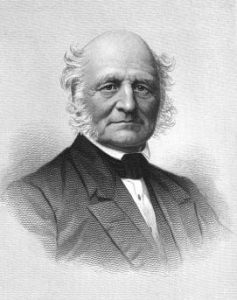There have been many interesting characters associated with NEHGS, but one president in particular holds my attention. Marshall Pinckney Wilder (1798–1886), the eighth president of the society (for the long period 1868–86), held many posts other than his presidency at NEHGS, including service as president of the Massachusetts Horticultural Society and as a trustee of the Massachusetts Agricultural College. Wilder was also a dedicated horticulturist himself and grew many hybrids of camellias and pear trees. Tragically, he lost 798 specimens of the 800 camellias in his collection in a greenhouse fire in 1839, but he somehow managed to restore his collection to an impressive level before a visit from members of the Massachusetts Horticultural Society the following year. In order to gain a better understanding of why Wilder was so interested in camellias and pears, I decided to examine some of the symbolism of the fruit and flower to see if it provided any insight into Marshall’s wider interests, most notably genealogy and family history.
Camellias are originally from China and they represent love, admiration, and desire. They can also be found in Japan and are commonly called “the Japanese rose.” The plant is symbolic of two lovers – the calyx (the part that holds the petals together) represents the man and the flower represents the woman. An interesting property of camellias provides an explanation for their symbolism. Typically, when the petals of a flower fall off, the calyx stays intact. The calyx on camellias however also falls off with the petals, representing the union between the man and the woman and how they stay together even when they fall.
The Latin translation of camellia means “helper to the priest”; it was named after the Jesuit botanist Georg Joseph Kamel, who practiced pharmaceutical botany in the late seventeenth century. Kamel is famed for his work in the Philippines, where he lived for most of his life, dedicated to finding treatments from native plant sources. There actually is no record of Kamel working with camellias, but the flower was named in his honor to commemorate his many contributions to the world of pharmacy. The camellia is also medicinal and can be used to treat burns and scalds when the flower is mixed with sesame oil.
Pears are an ancient fruit: their descriptions in Homer’s Odyssey shows that they were cultivated in Greece around 3,000 years ago. There is also a great tradition in France of cultivating the fruit – indeed, one of Wilder’s preferred types of pear was the Beurre d’Anjou from France. In Christianity, the pear tree is also symbolic of Christ’s love for mankind, holding similar themes to camellias.
[As] a dedicated hybridizer he would be well-informed of the symbolism of the plants he chose to grow, and choosing ones that are so representative of love is very telling.
This says a lot about Wilder’s personality; as a dedicated hybridizer he would be well-informed of the symbolism of the plants he chose to grow, and choosing ones that are so representative of love is very telling. Wilder was devoted to his family and named a species of camellia after them, known as camellias Wilderi. He had three wives and was dedicated to each one intensely before their respective deaths. He was father to fourteen children, and each one went on to marry and continue the lineage of the Wilder family. It is important to consider that Wilder’s presidency at NEHGS can be linked to his horticultural interests, as both disciplines require the cultivation and care for “roots” – literally in plants and metaphorically in family history. Horticulture and family history both require dedication, scrupulous research, and passion so strong that it permeates the way in which one lives one’s life, which can safely be said is the way that Wilder lived his. I will finish with a quote that has been paraphrased but sums up Wilder’s attitudes towards genealogy and how he feels it relates to the ones you love the most – your immediate family:
Democracy ought highly to estimate the purpose and the province of genealogy; for the range of the subject at once shows us that we must no longer confine our interest in humanity to the great ones of the earth, to princes, and nobles. Genealogy with us knows no distinction between the great and the small. It recognizes simply the lineage of families limited by natural descent.
Sources
http://www.dorchesteratheneum.org/page.php?id=518
https://www.rindgehistoricalsociety.org/?page_id=198
https://hort.purdue.edu/newcrop/janick-papers/pearinhistory.pdf
http://scua.library.umass.edu/ead/murg002_3_w55
https://www.geni.com/people/Marshall-Wilder/6000000026909428493
http://www.naturalmedicinalherbs.net/herbs/c/camellia-japonica=camellia.php
https://www.ftd.com/blog/share/camellia-meaning-and-symbolism
Share this:

About Georgiana Day
Georgiana is currently studying for a BA Hons in History and English Literature at the University of Edinburgh. She is working at NEHGS in Boston as a summer intern through the Saltire Foundation. She was particularly driven to take up the internship after the passing of her Gran, who was very invested in family history. In her spare time, Georgiana enjoys singing and acting and has taken part in many student productions during her University years.View all posts by Georgiana Day →
